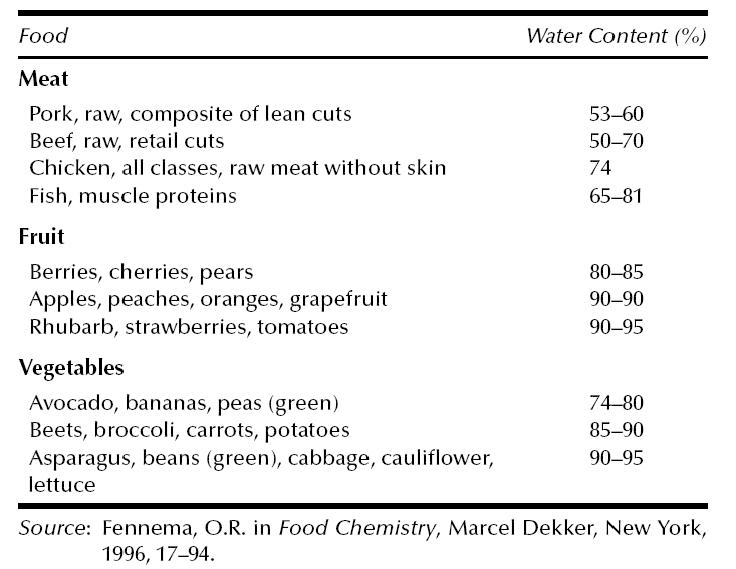Site pages
Current course
Participants
General
Module 1. Moisture content and its determination.
Module 2. EMC
Module 3. Drying Theory and Mechanism of drying
Module 4. Air pressure within the grain bed, Shred...
Module 6. Study of different types of dryers- perf...
Module 5. Different methods of drying including pu...
Module 7. Study of drying and dehydration of agric...
Module 8. Types and causes of spoilage in storage.
Module 9. Storage of perishable products, function...
Module 10. Calculation of refrigeration load.
Lesson 1. Moisture content
1.1 Food and Moisture
Food is any substance consumed to provide nutritional support for the body. It is usually of plant or animal origin, and contains essential nutrients, such as carbohydrates, fats, proteins, vitamins, or minerals. All foods content solids, water and other chemicals. The moisture contained in a material comprises all those substances which vaporize on heating and lead to weight loss of the sample. The weight is determined by a balance and interpreted as the moisture content. According to this definition, moisture content includes not only water but also other mass losses such as evaporating organic solvents, alcohols, greases, oils, aromatic components, as well as decomposition and combustion products. The moisture content also called as moisture assays is one of the most important analyses performed on most of the food products. Table 1 gives the general idea about the moisture content of different foods. Water activity measurements parallel to the moisture content is also an important parameter for quality and stability of food.
Table 1: Water Contents of Various Foods

1.2 Types of bonding of moisture in the product
The moisture in food can be present in different forms which are decided by type of bonding with solids (Fig 1). It is available in following forms:
Free water: water on the surface of the test substance and it retains its physical form
Absorbed water: water in large pores, cavities or capillaries of the test substance
Water of hydration: Occluded in lattice ions or water of crystallization coordinately bonded to ions.
Fig 1.1 Types of bonding of moisture in food products
1.3 Esimation of Moisture Content
Moisture content is the quantity of water contained in a food material. Moisture content is used in a wide range of scientific and technical areas, and is expressed as a ratio, which can range from 0 (completely dry) to the value of the materials' porosity at saturation. It can be given on a volumetric or mass (gravimetric) basis. Moisture content is expressed as a percentage of moisture based on total weight (wet basis) or dry matter (dry basis). Wet basis moisture content is generally used. Dry basis is used primarily in research. The moisture content is expressed by following formulae.
where, M is moisture content on a percent basis, w is total weight (also called as wet weight) and d is dry weight.
Based on the different forms of moisture present in the food the method used for measurement of moisture may estimate more or less moisture content. Therefore, for different food products Official Methods of moisture measurement have been given by agencies like AOAC (Association of Official Analytical Chemists), AACC (American Association of Cereal Chemists) and BIS (Bureau of Indian Standards).
1.4 Importance of Moisture Content in Foods
Proper moisture content is essential for maintaining fresh, healthy foods. If a food is too moist or too dry, it may not be suitable to eat and will not taste as good as it would if it had the correct moisture content. Most of the food products contain moisture. The moisture content per cent is seldom of interest. Rather, it shows whether a product intended for trade and production has standard characteristics such as:
1. Storability
2. Agglomeration in the case of powders
3. Microbiological stability
4. Flow properties, viscosity
5. Dry substance content
6. Concentration or purity
7. Commercial grade (compliance with quality agreements)
8. Nutritional value of the product
9. Legal conformity (statutory regulations governing food)
In addition to above characteristics, the determination of moisture content plays important role commercially with respect to following aspects:
1. Freshness
Fresh, ripe fruits and vegetables are moist to the touch. As they age and begin to rot, some dry out and some pick up excess moisture and begin to mold.
2. Labeling
Food industries require a minimum or maximum percentage of moisture on certain foods in order for them to be packaged and labeled. If they don't fit to these standards, the foods cannot be sold.
3. Cost
In processed foods, the percentage of water in a product can determine its final price. Generally, a product with more water will cost less.
4. Processing
Biologists and manufacturers need to know the moisture content of food to ensure that it's processed and packaged in a safe, stable way.
5. Quality
Moisture content determines the way most foods taste, feel and look. It is one of the important ways to measure food quality.
6. Shelf life
Shelf life of product depends on its moisture content at the time of packaging and rate of moisture gain during storage which is also called as sorption isotherm study.